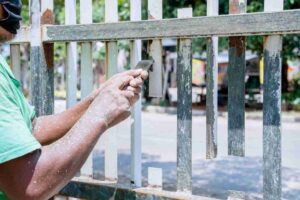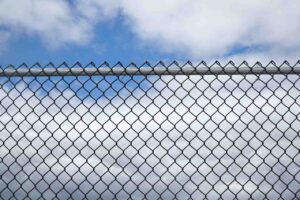Can you electrify a chain link fence?
Have you ever considered electrifying your chain link fence for enhanced security? Electric fences are a powerful deterrent. It provides a sense of security and peace of mind whether you’re out or at home. You may be wondering; can you electrify a chain link fence? While this may be a DIY project, there are considerations to be made before starting the project. Although contrary to common belief, electrifying a chain-link fence doesn’t mean directly electrifying the fence itself, as it lacks insulation.
The great news is that converting a chain link fence into an electric one is doable. With our quick step-by-step guide, you’ll be able to add protection to your home or property against any intruders or even wild animals. While it’s best to prioritize your safety with the matter, let’s also explore the nuances and reasons why bringing in a professional might be the smarter choice in the latter part.
Let’s welcome you to the electrifying world of chain link fences
How Does an Electric Fence Work?
An electric fence operates by having the energizer emit a voltage pulse per second, transmitting it through wires to the fence strands. When touches the fence, current flows from the live fence wires into the body and disperses into the ground.
Ground rods are installed to capture the leaked charge in the soil. The current then returns to the energizer, closing the circuit. This additional current strengthens your fence’s power, underscoring the importance of having an adequate number of ground rods and effective grounding.
Can You Electrify a Chain Link Fence?
Before electrifying a chain link fence, it’s important that there are many types of chain link fences. To properly electrify a chain link fence, the correct approach involves the around it, and it’s important to ensure insulation between both fences. If you just run an electrical current through an existing fence, the electricity will leak into the ground causing potential issues and danger.
Prepping to Electrify a Chain Link Fence
Before you get started to electrify your fence, you will need electric fence energizers. Energizers generate electric pulses on the fence at approximately one-second intervals. There is a one-second pause between pulses during which no electrical energy is present on the barrier. While most user manuals for electric fence energizers contain installation instructions, they may vary at some point but typically have the same installation principles
Here are the other materials and equipment needed:
- Insulators and tensioning tools placed on line posts and tension posts.
- Wires positioned away from the fence to prevent shorts and false alarms.
- “Loops” at the corner and end posts for the necessary horizontal and vertical wire connections, which are essential for completing the electric fence circuit and making it work.
- Signs placed on the fence in accordance with general legal regulations.
- An energizer correctly grounded, that has a live out and live return as well as a ground out and ground return system.
- Monitoring or alarm devices if ever you intend to link your electric fence to these systems.
We’ll guide you through the necessary steps below, from selecting the right tools to ensuring safety and efficiency when it comes to how to test an electric fence.
How to Electrify a Chain Link Fence
Step 1: Decide Where to Position Your Electric Fence Wires
The initial step in electrifying a chain link fence involves deciding on the positioning of your electric fence.
If your fence is situated in a remote area and the purpose of the electric fence is to deter animals like bears, it’s best to install the electric fence wires on the exterior side of the fence.
On the other hand, if you’re living in a more populated area, there may be regulations regarding the placement electricity on a section of the fence that could accidentally be touched by a passerby. In that case, you might prefer to provide electricity to only the top and inside of your existing chain link fence. This setup limits access to an actual person intentionally attempting to breach or climb over the fence.
Step 2: Retrofitting and Fabricating Offset Brackets
Your next step involves crafting offset brackets to ensure the wires are properly separated.
When you’re dealing with electric fences, it’s important to prevent any contact between the wires and other metal fence components. When contact happens, it can result in a short circuit, diminishing your fence’s effectiveness or even making it live. If your electric fence is linked to an alarm system or siren, these short circuits can trigger numerous false alarms.
Electric fence insulators are designed to maintain a safe distance between wires and the fence. However, when retrofitting a fence, you might encounter limited space between the new wires and the existing structure.
Offset brackets can be created using materials like pipes or angle iron. They can be securely welded to brace bands, which can then be bolted into position. Welding offset brackets directly to your existing fence is usually only necessary for tension posts. For all other areas, utilizing bolt-on brackets is a suitable approach.
Step 3: Choose the Right Number of Strands for Your Electric Fence
After fabricating your offset brackets, you need to determine the desired number of strands for your fence to convert your chain link fence into an electric one.
The number of strands directly corresponds to the number of electrical wires you’ll use. Typically, this is an even number because an electric fence functions as a circuit, requiring both an outgoing and a returning wire to complete the circuit.
This is the part where it’s crucial if you plan to incorporate any monitoring equipment into your fence setup, as the fence wires play a vital role in relaying information about any shorts on the fence to your fence security system.
Step 4: Pick the Right Electric Fence Energizer
Your next step in retrofitting your existing chain link fence is all about selecting the right electric fence energizer.
Electric fence energizers are typically designed to power a specific length of wire, so it’s crucial for you to calculate the fence’s dimensions and the number of wire strands it will feature. As you proceed, you might also contemplate the option of utilizing multiple energizers for different fence zones. Additionally, you’ll need to make a choice between a solar-powered energizer and a plug-in model, depending on your installation location and the availability of a power source.
If you end up choosing a solar-powered energizer, keep in mind that it will require a storage battery, which you’ll have to replace periodically. This ensures your fence remains operational even during dark or cloudy periods.
Step 5: Purchasing the Essential Electric Fence Materials: Wire, Chain Link Electric Fence Insulators, and Tensioners
The next thing you’ll need is the essential materials like wires, chain link electric fence insulators, and tensioners.
Electric Fence Wires
Electric fences usually use high-tensile galvanized wire, but there are alternatives like stainless steel and even aluminium. It’s essential to purchase enough wire to cover all the strands of your fence, including loops and connections at corners, ends, and gates. Don’t forget to consider clamps and ferrules for wire joins.
Electric Fence Insulators
Electric fence insulators come in various options, but in most cases, a straightforward plastic insulator that can be securely fastened to your post or bracket is the top choice. They also come in different colors and are UV resistant, ensuring they endure without degrading or cracking over time under the sun.
Electric Fence Tensioners
When it comes to tensioning equipment for electric fences, you’ll typically find ratchet-type tensioners and strain insulators. These are positioned at the fence’s corners and ends, as the name implies, to maintain the tautness of the electric fence wires. Remember that loose wires are more likely to cause shorts and false alarms on your fence.
Step 6: Ensuring Safety and Functionality: Signage, Grounding, and Gate Equipment for Your Electric Fence
As you wrap up your electric fence equipment shopping for your existing chain link fence, don’t forget to include safety signage, grounding equipment, and specialized gate components.
Safety signs are typically spaced approximately every 15 meters (around 50 feet) along electric fencing. Their purpose is to notify the public that the fence is electrified and should not be touched. It’s worth noting that this is a legal requirement for electric fences in many regions, so it’s a crucial step not to overlook.
Proper grounding of your electric fence is another essential aspect. Typically, this involves installing a copper ground spike near the energizer.
Electric fence gates are somewhat more intricate than the fence itself. They typically require electric fence wires on the gate’s body, and you’ll also need to run cables beneath the gate to connect both sides of the fence. For expert advice on the best gate options, the right person to consult is your electric fence contractor or supplier.
How to Test an Electric Fence in 6 Simple Ways
You have various options on how to test an electric fence, depending on the tools available in your local hardware. Let’s explore six methods for you to check your electric fence while prioritizing safety.
Using Your Hearing
Find a quiet spot within the fenced area, standing about a foot from the electric fence. Listen closely for the pulsing electricity – it’s a subtle buzzing or humming sound. However, bear in mind that silence doesn’t always indicate a non-functioning fence. Unusual sounds may necessitate a professional’s inspection
Testing With a Plastic-Handled Screwdriver
In a pinch, a plastic-handled screwdriver can serve as a makeshift tool. The plastic handle is non-conductive, ensuring your safety from shocks. Remember to avoid touching the metal parts of the screwdriver and refrain from direct contact with the fence wires.
Testing With a Compass
That trusty compass you use for navigation can also help with your electric fence. Hold it a few inches from each wire, ensuring no accidental contact with the fence. Keep it steady for about 30 seconds, and the compass arrow will react near charged wires.
Electric Fence Voltmeter
Invest in a reliable voltmeter, available at home improvement stores for around $20 to $50. It’s a name that matches its reliability.
Non-Contact Voltmeter
Consider purchasing a non-contact voltmeter or voltage tester , which can be found at most home improvement retailers for approximately $20 to $30. They’re user-friendly and won’t necessitate physical contact with the fence wires.
Electric Fence Indicator Lights
When a professional installs your electric fence, you might want to include electric fence indicator lights as part of the package. These lights are positioned at intervals along the fence wires and illuminate when the fence is functioning correctly. It’s a smart addition, especially for long-term fence maintenance.
Is It Legal to Electrify a Chain Link Fence?
In many areas, laws regulate the construction and operation of electric chain link fences, and it’s vital to be aware of these rules and regulations. If you’re a property owner planning to install an electric fence, you could potentially face legal issues in case of negligence or installation errors that result in harm caused by the electric fence.
As you contemplate and decide to install an electric fence to secure your property, it’s natural to have concerns about the legal aspects. While electric fences are generally permitted in the United States, local regulations can vary. To ensure compliance, checking your city’s specific bylaws before proceeding with the installation is crucial.
Risks and Disadvantages of an Electric Fence
It’s important to understand that electric fencing, while highly effective at deterring intruders, comes with its own set of drawbacks that you should take into account.
Cost: Electric fencing can be a significant investment. The initial installation cost tends to be on the higher side, and it’s essential to budget for regular maintenance and part replacements to keep it in top working condition.
Safety Concerns: Your safety and that of others, as well as animals, is paramount. An improperly installed or maintained electric fence can pose serious hazards. Electric shocks can lead to injuries or even fatalities, especially if the fence lacks clear markings and visibility.
Power Supply: Ensuring a constant power supply can be challenging, especially in areas prone to power outages. Without a reliable power source, your electric fence might not provide the necessary security, leaving your property vulnerable to intruders.
Interference: Various external factors like lightning, power surges, or electromagnetic interference from nearby sources can disrupt the electric fence’s operation. These interferences can render the fence inactive precisely when you need it most.
Permits and Approval: Depending on your location, installing an electric fence may require special permits and approvals from local authorities or neighbors. This can add complexity and cost to the installation process, potentially causing delays. Don’t forget that a certificate of compliance (COC) must be signed off by a registered Electrician upon project completion.
Maintenance: Keeping your electric fence in optimal working condition demands regular attention. You’ll need to conduct routine voltage level checks, inspect fence wires, and ensure the energizer is functioning correctly. Neglecting maintenance can jeopardize the fence’s ability to provide the security you’re seeking.
Consider Hiring a Professional Contractor
Opting for a skilled contractor guarantees a right-from-the-start, error-free project. At Top Rail Fence, we provide top-notch materials and expert installation services, giving you the assurance of the final result. When you entrust us with your electric fence installation, you’re not just securing your property—you’re investing in enhanced safety and your long-term peace of mind.


